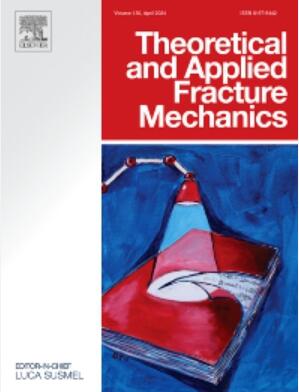隧道周围岩石在单轴荷载作用下的应力演变:PFC3D-GBM 建模和力链分析的启示
IF 5
2区 工程技术
Q1 ENGINEERING, MECHANICAL
引用次数: 0
摘要
在地下工程中,围岩应力状态的演变可有效揭示其断裂机制。为了精确描述这些微观信息,本研究利用基于粒子流代码的三维晶粒模型(PFC3D-GBM)构建了一个预留孔洞代表隧道的正方形数值试样,并对其施加单轴载荷。该模型在三维尺度上区分了不同类型的矿物结构和内部力链网络。此外,还对隧道周围顶部、底部、左侧和右侧区域的力链网络演变进行了定量分析。计算了各种结构应力状态下的抗断裂能力,然后从抗断裂能力的角度讨论了断裂机制。研究结果表明,在加载初期,隧道两侧出现了一些级别较高的红色力链。随着荷载的增加,红色力链网络从隧道两侧延伸至试样的上下两端。所有力链的平均值和总值在峰值载荷之前呈上升趋势,峰值载荷之后呈下降趋势。特定结构内力链的平均值可以准确反映该结构的微观力学性能。隧道左侧和右侧的力链平均值,无论是起点还是上升速率,都高于隧道上部和下部的力链平均值。所有力链的方向分布相对均匀,但水平较高的力链一般与加载方向一致。隧道左右两侧破碎程度高的根本原因是这些区域比上下区域承受了更大的外部荷载,而不是这些区域本身更容易发生断裂。本文章由计算机程序翻译,如有差异,请以英文原文为准。
Stress evolution in rocks around tunnel under uniaxial loading: Insights from PFC3D-GBM modelling and force chain analysis
In underground engineerings, the evolution of the stress state in the surrounding rocks can effectively reveal its fracture mechanism. To precisely describe this microscopic information, the present study utilizes the three-dimensional Grain-based model based on Particle Flow Code (PFC3D-GBM) to construct a square numerical specimen with a pre-existing hole representing a tunnel and subjected it to uniaxial loading. In this model, different types of mineral structures and internal force chain networks are distinguished at a three-dimensional scale. Furthermore, the evolution of force chain networks in the top, bottom, left and right regions around the tunnel is quantitatively characterized. The anti-fracture capability depending on stress state of various structures is calculated and then the fracture mechanism from the point of anti-fracture capability is discussed. The research results indicate that at at the beginning of loading, some red force chains with higher level have appeared on both sides of the tunnel. As the load goes on, red force chain network extending from both sides of the tunnel to the upper and lower ends of the specimen have emerged. The average value and sum value of all force chains show an increasing trend before the peak load and a decreasing trend after the peak load. The average value of force chains within a specific structure can accurately reflect the microscopic mechanical properties of that structure. The average values of force chains on the left and right sides of the tunnel are higher, both in terms of starting points and ascending rates, than those in the upper and lower regions of the tunnel. The orientation distribution of all force chains is relatively uniform, but force chains with higher level are generally align with the loading direction. The fundamental reason for the high degree of fragmentation on the left and right sides of the tunnel is that these regions bear more external load than the upper and lower regions, rather than being inherently more prone to fracture.
求助全文
通过发布文献求助,成功后即可免费获取论文全文。
去求助
来源期刊

Theoretical and Applied Fracture Mechanics
工程技术-工程:机械
CiteScore
8.40
自引率
18.90%
发文量
435
审稿时长
37 days
期刊介绍:
Theoretical and Applied Fracture Mechanics'' aims & scopes have been re-designed to cover both the theoretical, applied, and numerical aspects associated with those cracking related phenomena taking place, at a micro-, meso-, and macroscopic level, in materials/components/structures of any kind.
The journal aims to cover the cracking/mechanical behaviour of materials/components/structures in those situations involving both time-independent and time-dependent system of external forces/moments (such as, for instance, quasi-static, impulsive, impact, blasting, creep, contact, and fatigue loading). Since, under the above circumstances, the mechanical behaviour of cracked materials/components/structures is also affected by the environmental conditions, the journal would consider also those theoretical/experimental research works investigating the effect of external variables such as, for instance, the effect of corrosive environments as well as of high/low-temperature.
 求助内容:
求助内容: 应助结果提醒方式:
应助结果提醒方式:


